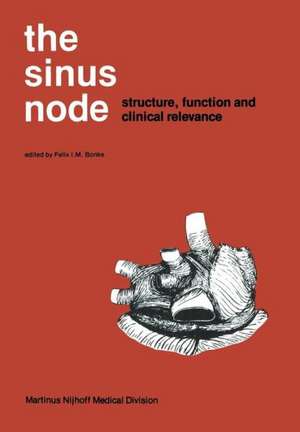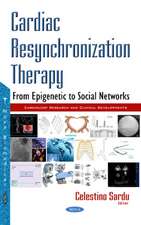The Sinus Node: Structure, Function, and Clinical Relevance
Autor F.I. Bonkeen Limba Engleză Paperback – 13 oct 2011
Preț: 382.26 lei
Preț vechi: 402.38 lei
-5% Nou
Puncte Express: 573
Preț estimativ în valută:
73.17€ • 79.50$ • 61.50£
73.17€ • 79.50$ • 61.50£
Carte tipărită la comandă
Livrare economică 21 aprilie-05 mai
Preluare comenzi: 021 569.72.76
Specificații
ISBN-13: 9789400997172
ISBN-10: 9400997175
Pagini: 476
Ilustrații: 468 p.
Dimensiuni: 170 x 244 x 25 mm
Greutate: 0.75 kg
Ediția:Softcover reprint of the original 1st ed. 1978
Editura: SPRINGER NETHERLANDS
Colecția Springer
Locul publicării:Dordrecht, Netherlands
ISBN-10: 9400997175
Pagini: 476
Ilustrații: 468 p.
Dimensiuni: 170 x 244 x 25 mm
Greutate: 0.75 kg
Ediția:Softcover reprint of the original 1st ed. 1978
Editura: SPRINGER NETHERLANDS
Colecția Springer
Locul publicării:Dordrecht, Netherlands
Public țintă
ResearchCuprins
Section one: Function and dysfunction of the sinus node.- Function and dysfunction of the sinus node: clinical studies in the evaluation of sinus node function.- Measurement of sinus node recovery time after atrial pacing.- Programmed atrial stimulation used for the calculation of sinoatrial conduction time (SACT) in man.- The pattern of the first and second return cycle after premature atrial stimulation.- Programmed atrial stimulation and rapid atrial pacing in patients with sinus pauses and sinoatrial exit block.- A new technique for measurement of sinoatrial conduction time.- Relevance of diagnostic atrial stimulation for pacemaker treatment in sinoatrial disease.- The response of the sinus node to premature stimulation of the atrium studied with microelectrodes in isolated atrial preparations of the rabbit heart.- Review of the significance of drugs in the sick sinus node syndrome.- Effect of propranolol on normal and abnormal sinus node function.- Dual effect of verapamil on sinus node function in man.- General conclusions: Limitations of sinus node function testing in patients with known or suspected sinus node disease.- Section two: Relation between structure and function of the sinus node.- The fine structure of the sinus node: a survey.- The development of the sinoatrial node.- Techniques and problems in correlating cellular electrophysiology and morphology in cardiac nodal tissues.- Ultrastructural and functional aspects of the rabbit sinoatrial node.- General comments.- Section three: Electrophysiology of the sinus node.- A general introduction about the current status of the electrophysiology of the sinus node.- Characterization of a two-component upstroke in the sinus node subsidiary pacemakers.- Pacemaker shifts in the sinus node: effects of vagal stimulation, temperature, and reduction of extracellular calcium.- Cardiac glycosides and pacemaker activity of the sinus node: a micro-electrode study on the isolated right atrium of the rabbit.- Effects of polarization and of inhibitors of ionic conductances on the action potentials of nodal and perinodal fibers in rabbit sinoatrial node.- The acceleratory action of the vagus on the sinus node.- General conclusions.- Section four: On the mechanism of pacemaking in the sinus node.- Ionic currents in rabbit sinoatrial node cells.- Fine structure of the small sinoatrial node specimen used for the voltage clamp experiment.- Membrane currents underlying rhythmic activity in frog sinus venosus.- Involvement of the chloride ions in the membrane currents underlying pacemaking activity in frog atrial trabeculae.- Which ions are important for the maintenance of the resting membrane potential of the cells of the sinoatrial node of the rabbit?.- Does spontaneous activity arise from phase 4 depolarization or from triggering?.- On the possible mechanism underlying spontaneous pacemaking.- General comments: ionic currents underlying spontaneous rhythm of the cardiac primary pacemaker cells.- Section five: Does the sinus node play a role in reentrant arrhythmias?.- Clinical evidence for sinus node reentry.- Sequence of atrial activation in patients with atrial echo beats.- Re-entry within the sinoatrial node as demonstrated by multiple micro-electrode recordings in the isolated rabbit heart.- Role of sinus node re-entry in the genesis of sustained cardiac arrhythmias.- General conclusions.- Literature Reference List.










